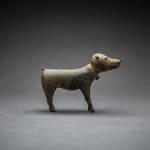Roman Bronze Dog, 100 CE - 300 CE
Bronze
7 x 10.2 cm
2 3/4 x 4 1/8 in
2 3/4 x 4 1/8 in
SF.015
Further images
A charming representation of a household animal, this small bronze statuette of a dog may be a representation of someone’s pet, for a collar has been added to the animal...
A charming representation of a household animal, this small bronze statuette of a dog may be a representation of someone’s pet, for a collar has been added to the animal showing its domestication, so too suggested by the lines on his nose representing a muzzle. He may once have had a long tail (now unfortunately lost) but the dog is full of character, for his tongue is shown hanging out, possibly suggesting that he was meant to be depicted as panting. Such a statuette may have been a simple ornament, furniture applique, or it could have been an image of a loved, deceased pet, and placed among similar statuettes of family members in the household shrine to pray for their protection and honour their memory.
In ancient Rome the dog was seen as the loyal, devoted figure to his master, whether that master returns the devotion or not. The well-known mosaic, Cave Canem (Beware of Dog) shows how dogs were appreciated in Rome as guardians of homes just as they had been in earlier cultures and are still today. The great Latin poet Virgil, wrote, “Never, with dogs on guard, need you fear for your stalls a midnight thief”(Georgics III, 404ff) and the writer Varro, in his work on how to live in the countryside, writes that every family should have two types of dog, a hunting dog and a watchdog (De Re Rustica I.21). The Romans had many pets, from cats to apes, but favored the dog above all others. Dogs feature in many mosaics, wall frescoes, in poetry and prose. There is a large series of Roman reliefs showing men and women with their canine companions.
Dogs are mentioned in the Roman law code as guardians of the home and flocks. In one case which was recorded, a farmer brings a suit against his favored because the neighbour dogs rescued the farmer's hogs from wolves and the neighbor's then claimed ownership of the hogs. Varro claimed that no farm should be without two dogs and they should be kept indoors during the day and let free to roam at night in order to prevent just such a possibility as the one discussed above. He also suggested that a white dog should be chosen over a black one so that one could distinguish between one's dog and a wolf in the darkness or the twilight of early morning.
In ancient Rome the dog was seen as the loyal, devoted figure to his master, whether that master returns the devotion or not. The well-known mosaic, Cave Canem (Beware of Dog) shows how dogs were appreciated in Rome as guardians of homes just as they had been in earlier cultures and are still today. The great Latin poet Virgil, wrote, “Never, with dogs on guard, need you fear for your stalls a midnight thief”(Georgics III, 404ff) and the writer Varro, in his work on how to live in the countryside, writes that every family should have two types of dog, a hunting dog and a watchdog (De Re Rustica I.21). The Romans had many pets, from cats to apes, but favored the dog above all others. Dogs feature in many mosaics, wall frescoes, in poetry and prose. There is a large series of Roman reliefs showing men and women with their canine companions.
Dogs are mentioned in the Roman law code as guardians of the home and flocks. In one case which was recorded, a farmer brings a suit against his favored because the neighbour dogs rescued the farmer's hogs from wolves and the neighbor's then claimed ownership of the hogs. Varro claimed that no farm should be without two dogs and they should be kept indoors during the day and let free to roam at night in order to prevent just such a possibility as the one discussed above. He also suggested that a white dog should be chosen over a black one so that one could distinguish between one's dog and a wolf in the darkness or the twilight of early morning.





